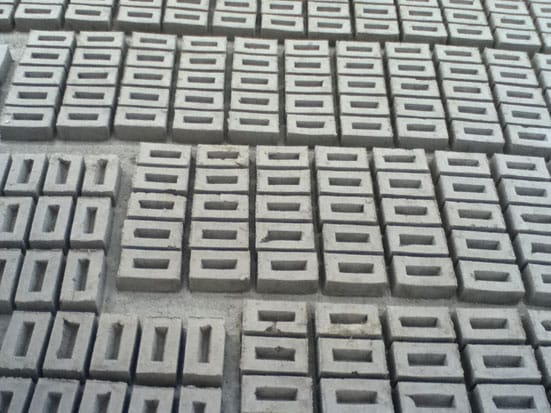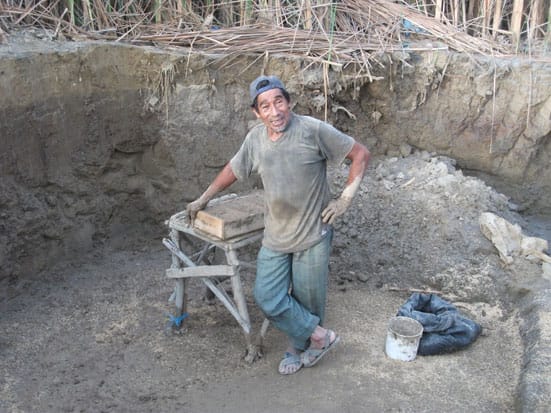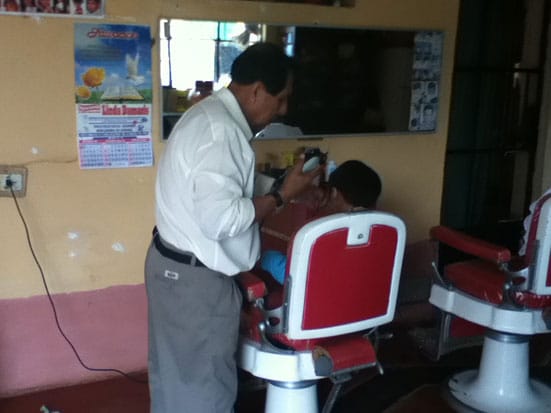18th January 2011 — 12th February 2011
On the occasion of her exhibition 'Header Stretcher Soldier Sailor Shiner Rowlock' at the Vitrine Gallery (see below), Laura Wilson presents an account of her recent travels in Peru researching bricks. Laura Wilson has been awarded a Winston Churchill Memorial Fellowship for 2010/11 and with this she has travelled to China and Peru and will be travelling to Europe later this year.
The second phase of my travel fellowship with the Winston Churchill Memorial Trust took me to Peru. Starting in Lima I visited the historic sites including the Huaca Pucllana, a huge adobe and clay pyramid located right in the centre of the city. From there I travelled over the Andes to the ancient city of Cusco, once the capital of the Inca Empire. This city, allegedly the navel of the world, is dotted with archaeological sites. One of them called Sacsayhuaman (pronounced 'Sexy Woman') is an enormous dry stone walled complex, which overlooks Cusco. I spent some time visiting other sites in the Sacred Valley before travelling to the awe-inspiring Inca citadel Macchu Pichu. From there I returned briefly to Lima to meet with Marcial Blondet, an engineer who has developed technology for making buildings which will be resistant to earthquakes. The next day I made my way up the North coast via Trujillo and Chiclayo to a little town called Illimo where I was invited to stay with a Peruvian family and attend a baptism, with the promise of a visit to the local brick factory.
Communicating to the family with my limited Spanish which consisted mainly of 'Hola', '¿Como estas?', 'Si' and a lot of nodding, I was welcomed into their home with open arms. Built by the Father of the family, Juan Riojas Marcelo, this much loved mud-floor, brick-and-tin-roof structure is the centre of family life and has been witness to their eight children growing up and more recently giving birth to their own offspring. The street entrance to the house is a barber's shop run by Juan and when not cutting people's hair he sows the land; the barbershop also doubles up as a newsagents where his wife sell drinks and confectionary from the window. Each New Year in Illimo, now coinciding with my visit, there is a two-week festival of The Three Kings celebrating the visit of the Three Wise Men to Jesus. The celebrations fill the town with pink candy floss on sticks, balloons, piñatas and many brass bands marching the streets 24 hours a day. Simultaneously the home I was staying at was buzzing with activity due to baptism celebrations - the reuniting of brothers, sisters, children and grandchildren, and cousins meeting each other for the first time, sharing and playing with their new Christmas toys. Meanwhile, the Mother of the family, Joida Rengifo Cueva, spent her time waiting on everyone hand and foot- caring and providing for all the visitors.
Day 11 in Peru was an early start to the brick factory. Located very close to the house in Illimo, the sun was rising and as it did the bricks and clay pits glowed a bright orange. At this factory they make three types of brick, King Kong (15cm in length) used in one story buildings, Pandereta (12cm in length) used on the second floor of buildings and Tubo, used on the roof. Several factories within a factory, each worker on site is freelance and required to produce a certain quota of bricks before they can knock off for the day. The factory has no walls and the workers must burrow deeper and deeper into the landscape for more clay. No foreign material is used to produce the bricks, everything is from the site - simply water from the nearby lake and clay and sand from the land, it is totally self sufficient. There is no wastage and any deformed bricks are broken back down to raw material.
One of the employees I met was a man in his 60s called Gerusmo Guiteriez, he has worked there since he was 9 years old and he produces Pandereta bricks. Watching the process of brick making is mesmerising. Gerusmo picks up a clump of clay throws it into the mould, pats it down, scrapes off the excess with a stick, dusts it with the sand, pulls out the struts which the make the holes inside, and turns out the mould on the ground beside the previous set. Then he starts the whole process again. So effortless and mechanical.
Gerusmo lives adjacent to the factory with his family where he also keeps beehives and produces honey though the sweet fluid is only available in Illimo during the festival. In the Origin of Species, Charles Darwin wrote, with reference to honeybees, 'He must be a dull man who can examine the exquisite structure of a comb, so beautifully adapted to its end, without enthusiastic admiration.' This little micro-factory with its worker bee colony producing honey echoes many of the processes just a stone's throw away at the brick factory.
The baptism celebrations were like no other I had ever experienced, there was enough food to feed the five thousand, the God Parents each received a whole turkey, which they had to eat at a special table. Following tradition each visitor was invited to cut a lock of hair from the boy who had been christened. We danced until dawn. The next day surrounded by his family the young boy received his first real hair cut from his grandfather in the barbershop.
Laura Wilson
Laura Wilson's current exhibition at the Vitrine Gallery Header Stretcher Soldier Sailor Shiner Rowlock forms the latest chapter in her continuing research into bricks around the world. Her site-specific installation engages with the architectural history of Bermondsey and the unique exhibiting conditions of Vitrine Gallery.
Built behind glass, Wilson's human-scale brick structures respond to the bricked-up windows of many local buildings. This phenomenon, still to be seen in old houses across the country, is the result of the Window Tax introduced by William III in 1696 to raise funds for his wars in Ireland and overseas. This unpopular law, viewed as a tax on light and air, lasted for 150 years and resulted in the bricking-up of windows to avoid taxation. The exhibition title refers to the six possible orientations of a brick within a wall. Wilson uses bricks from a local factory that have been rejected because they do not meet brick specifications and cannot be sold. In this country brick sizes were standardised during the reign of George III, when bricks were taxed to fund wars in America. These historical taxes on bricks and windows resonate with contemporary revisions of the tax and benefit systems. Layers of Bermondsey's history permeate Wilson's installation. The foundations of a medieval abbey lie beneath the modern developments of Bermondsey Square. In the eighteenth century the area was a spa town and by the nineteenth century it was an industrial centre with tanning and leather works, and factories to process food unloaded at the wharves. Its notorious slums featured in Charles Dickens's Oliver Twist but now its warehouses are flats, restaurants, bars and museums.
PERFORMANCE Saturday 12 February 2011, 4pm, meet at the Vitrine Gallery.
Artist Mark Wayman will lead a walking tour around the local area. The initial coherence of the tour will disintegrate, leading to surprising new juxtapositions and intrusions.
Laura Wilson website: www.laurawilson.me
Brick Project Blog: www.brick-project.blogspot.com
Vitrine Gallery: www.vitrinegallery.co.uk
Ali MacGilp

Laura Wilson 'Header Stretcher Soldier Sailor Shiner Rowlock' Vitrine Gallery

Joida Rengifo Cueva

The Festival of the Three Kings, Illimo

Brick Factory, Illimo

Bricks, Illimo

Gerusmo Guiteriez

Juan Riojas Marcelo's Barber Shop
All images by Laura Wilson, 2011